Is The Market Rewarding Nanofilm Technologies International Limited (SGX:MZH) With A Negative Sentiment As A Result Of Its Mixed Fundamentals?
With its stock down 18% over the past three months, it is easy to disregard Nanofilm Technologies International (SGX:MZH). We, however decided to study the company's financials to determine if they have got anything to do with the price decline. Long-term fundamentals are usually what drive market outcomes, so it's worth paying close attention. Specifically, we decided to study Nanofilm Technologies International's ROE in this article.
ROE or return on equity is a useful tool to assess how effectively a company can generate returns on the investment it received from its shareholders. In other words, it is a profitability ratio which measures the rate of return on the capital provided by the company's shareholders.
View our latest analysis for Nanofilm Technologies International
How To Calculate Return On Equity?
The formula for ROE is:
Return on Equity = Net Profit (from continuing operations) ÷ Shareholders' Equity
So, based on the above formula, the ROE for Nanofilm Technologies International is:
0.6% = S$2.7m ÷ S$424m (Based on the trailing twelve months to December 2023).
The 'return' is the income the business earned over the last year. So, this means that for every SGD1 of its shareholder's investments, the company generates a profit of SGD0.01.
Why Is ROE Important For Earnings Growth?
Thus far, we have learned that ROE measures how efficiently a company is generating its profits. Based on how much of its profits the company chooses to reinvest or "retain", we are then able to evaluate a company's future ability to generate profits. Assuming all else is equal, companies that have both a higher return on equity and higher profit retention are usually the ones that have a higher growth rate when compared to companies that don't have the same features.
Nanofilm Technologies International's Earnings Growth And 0.6% ROE
As you can see, Nanofilm Technologies International's ROE looks pretty weak. Not just that, even compared to the industry average of 1.1%, the company's ROE is entirely unremarkable. For this reason, Nanofilm Technologies International's five year net income decline of 10% is not surprising given its lower ROE. However, there could also be other factors causing the earnings to decline. For example, the business has allocated capital poorly, or that the company has a very high payout ratio.
With the industry earnings declining at a rate of 10% in the same period, we deduce that both the company and the industry are shrinking at the same rate.
Earnings growth is an important metric to consider when valuing a stock. It’s important for an investor to know whether the market has priced in the company's expected earnings growth (or decline). This then helps them determine if the stock is placed for a bright or bleak future. Is MZH fairly valued? This infographic on the company's intrinsic value has everything you need to know.
Is Nanofilm Technologies International Making Efficient Use Of Its Profits?
Looking at its three-year median payout ratio of 33% (or a retention ratio of 67%) which is pretty normal, Nanofilm Technologies International's declining earnings is rather baffling as one would expect to see a fair bit of growth when a company is retaining a good portion of its profits. So there could be some other explanations in that regard. For instance, the company's business may be deteriorating.
Additionally, Nanofilm Technologies International has paid dividends over a period of three years, which means that the company's management is rather focused on keeping up its dividend payments, regardless of the shrinking earnings. Our latest analyst data shows that the future payout ratio of the company is expected to drop to 19% over the next three years. As a result, the expected drop in Nanofilm Technologies International's payout ratio explains the anticipated rise in the company's future ROE to 9.6%, over the same period.
Summary
In total, we're a bit ambivalent about Nanofilm Technologies International's performance. Even though it appears to be retaining most of its profits, given the low ROE, investors may not be benefitting from all that reinvestment after all. The low earnings growth suggests our theory correct. Having said that, looking at current analyst estimates, we found that the company's earnings growth rate is expected to see a huge improvement. To know more about the company's future earnings growth forecasts take a look at this free report on analyst forecasts for the company to find out more.
Have feedback on this article? Concerned about the content? Get in touch with us directly. Alternatively, email editorial-team (at) simplywallst.com.
This article by Simply Wall St is general in nature. We provide commentary based on historical data and analyst forecasts only using an unbiased methodology and our articles are not intended to be financial advice. It does not constitute a recommendation to buy or sell any stock, and does not take account of your objectives, or your financial situation. We aim to bring you long-term focused analysis driven by fundamental data. Note that our analysis may not factor in the latest price-sensitive company announcements or qualitative material. Simply Wall St has no position in any stocks mentioned.

 Yahoo Finance
Yahoo Finance 
